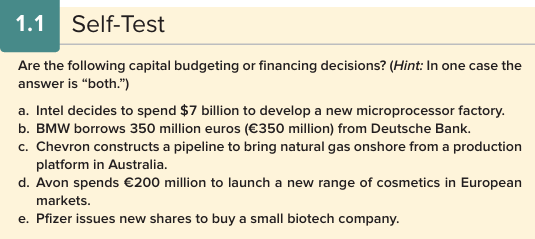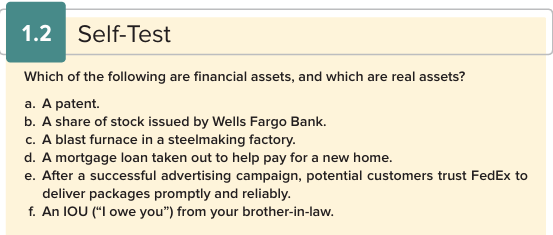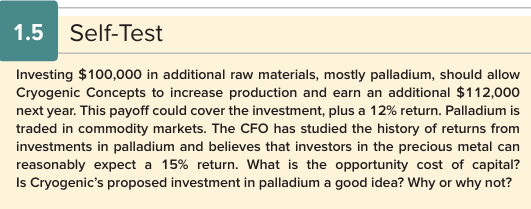1. Goals and Governance of the Corporation
1/127
There's no tags or description
Looks like no tags are added yet.
Name | Mastery | Learn | Test | Matching | Spaced |
|---|
No study sessions yet.
128 Terms
Plant and machinery, office buildings, and vehicles are (BLANK) assets
tangible
Brand names and patents are (BLANK) assets
intangible
Corporations finance assets by
1. borrowing
2. reinvesting profits back into the firm
3. selling additional shares
Investment decisions do what?
spend money
Financing decisions do what?
raise money for investment
The financial goal of the corporation is
maximizing value
Financial managers add value whenever the (BLANK) can (BLANK) to earn a (BLANK) return than its (BLANK) can earn for themselves
corporation, invest, higher, shareholders
corporate governance helps to align the interests of
managers and shareholders
investment forms that provide funds and advice to young companies in return for a partial ownership share
venture capitalists
Decision to invest in tangible or intangible assets
capital budgeting or capital expenditure (CAPEX) decision
decision on the sources and amounts of financing
financing decision
assets used to produce goods and services
real assets
financial claims to the income generated by the firm’s real assets
financial assets
When a company needs to raise money it can either invite (BLANK) to put up cash in exchange for a share of (BLANK), or it can promise to pay back the (BLANK)
investors, ownership, investors’ cash plus a fixed rate of interest
Investors that receive shares of stock and become shareholders, part-owners of the corporation
equity investors
equity investors contribute
equity financing
investors that lend cash and get repaid cash plus a fixed rate of interest later
debt investors
debt investors are
lendors
the choice between debt and equity financing is often called the
capital structure decision
the firm’s sources of long-term financing
capital
A firm that is seeking to raise long-term financing is said to be
raising capital
When a firm invests in something to produce the firm’s goods and services, it acquires
real assets
The firm finances its investment in real assets by issuing (BLANK) to investors
financial assets
Shares of stock and bank loans are (BLANK) assets
financial
Financial assets that can be purchased and traded by investors in public markets are called
securities
Financial managers say that “value comes mainly from the (BLANK) side of the balance sheet”
investment
If Microsoft shares traded for $230 each and there were 7.56 billion shares outstanding then Microsoft’s market value, market capitalization, or market cap is
$1,739 billion
Financing decisions add (BLANK) value compared to good investment decisions
less

a. Capital budgeting
b. financing
c. Capital budgeting
d. Capital budgeting
e. Both
The investment decision =
purchase of real assets
The financing decision =
sale of financial assets

a. real
b. financial
c. real
d. financial
e. real
f. financial
A business organized as a separate legal entity owned by stockholders
corporation
the owners of a corporation are not personally liable for its obligations
limited liability
set out the purpose of the business and how it is to be financed, managed, and governed
articles of incorporation
A corporation’s owners are called
shareholders or stockholders
A corporation is legally distinct from the shareholders. Therefore, the shareholders have (BLANK) and cannot be held personally responsible for the corporation’s debts
limited liability
Shareholders can lose their entire investment in a corporation, but
no more
Incorporation means that the bank will be more cautious in lending to you because it will have no recourse to your
other assets
When a corporation is first established and the shares are not publicly traded the company is said to be
closely held
When new shares are issued to raise additional capital, corporations are called
public companies
Public shareholders elect a (BLANK) who appoint the top managers and monitor their performance
board of directors
Makes corporations able to, in principle, live forever as even if managers quit or are dismissed, the corporation survives
separation of ownership and control
The separation of corporate ownership and control can also have a downside as it can open the door for managers and directors to act in their
own interests
Income generated by businesses that are not incorporated is taxed just once as
personal income
An important tax drawback to corporations is that they are a separate legal entity and are taxed
separately
supervises all financial functions and sets overall financial strategy
chief financial officer (CFO)
is the most important financial voice of the corporation and explains earnings results and forecasts to investors and the media
chief financial officer (CFO)
Responsible for financing, cash management, and relationships with banks and other financial institutions.
treasurer
Responsible for budgeting, accounting, and taxes.
controller
Below the CFO are usually a (BLANK) and a (BLANK)
treasurer, controller
main function is to obtain and manage the firm’s capital
treasurer
ensures that the money is used efficiently
controller

Treasurer: Fritz
Controller: Frieda
anyone responsible for an investment or financing decision
financial manager
A corporation’s roster of shareholders will usually include both (BLANK) and (BLANK) investors
risk-averse, risk-tolerant

No

Opportunity cost of capital: 15%
No, 12% < 15%

Agency problems arise when managers and shareholders have different objectives
Managers may empire-build with excessive growth, risk-aversive, or take excessive salaries
1. Internal controls and decision-making procedures
2. Compensation schemes that align managers' and shareholders' interest
3. Corporate governance systems